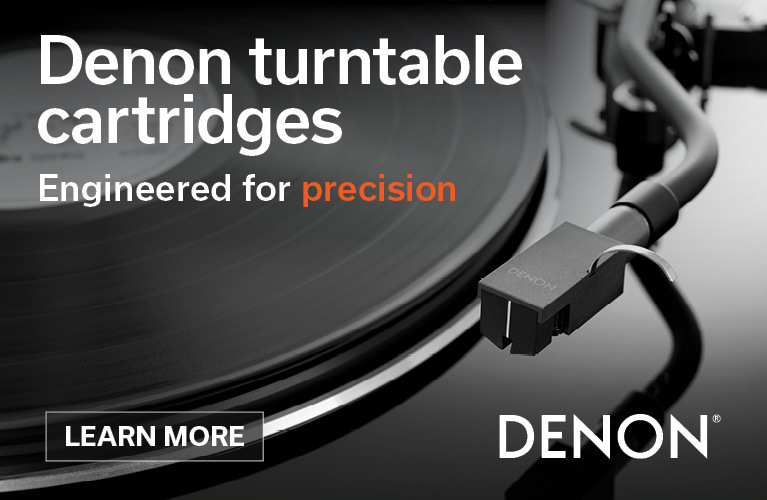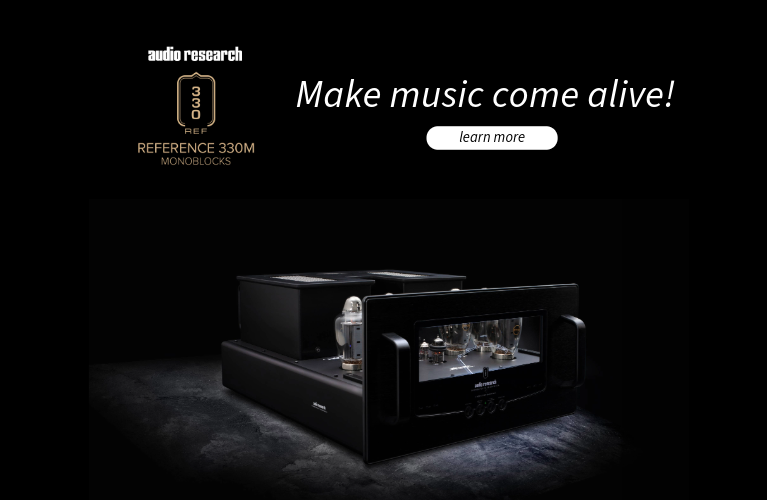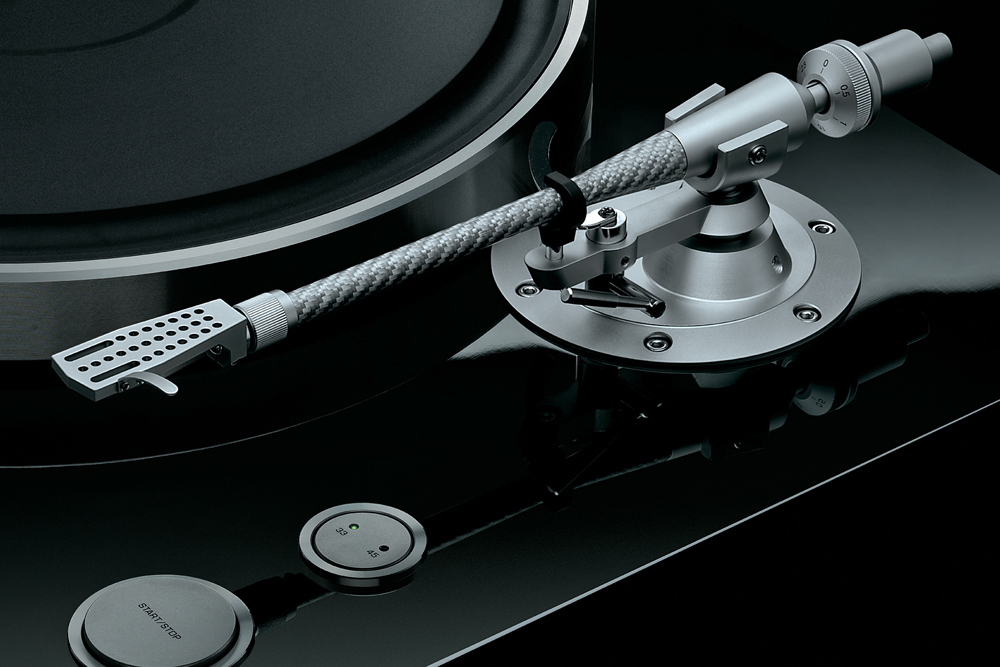Move over, you skinny lightweight turntables, because the serious muscle is here! Yamaha’s Gigantic and Tremendous GT-5000 Turntable is ready for a heavy follow-up review. Looking fabulous in high gloss piano black and beautifully machined belt driven aluminium platter, with the silvered carbon fibre tonearm adding to the bling factor. First, let’s explore the design and construction of this high-end turntable, then as a second opinion to editor Edgar Kramer’s original review (read here), I’ll also offer my sound performance impressions of this classy offering from Yamaha…
Big, Bold, Beautiful
Tracing its roots to the early 1980s Gigantic and Tremendous GT-2000, GT-1000 and GT-750 series of turntables the GT-5000 follows a very similar design format. Released in the year 2018, the GT-5000 is a member of Yamaha’s flagship 5000 series which includes the C-5000 preamplifier, M-5000 stereo power amplifier, NS-5000 loudspeakers and, more recently, flagship headphones.
Unpacking the GT-5000 box first reveals a small accessory case that contains the turntable belt, power cord, stroboscopic speed disc, strobe light, turntable belt and a pair of soft white cotton gloves. Also included is a rather neat wooden LP stand featuring Yamaha’s iconic triple tuning fork logo. Next comes the massive plinth with attached internal motor, tonearm and large footers. Weighing some 14 kilograms, a straight-back lift is required.
The plinth is constructed from layered particle board designed to soak up unwanted vibrations from reaching the platter and tonearm. It’s beautifully finished in highly polished Gloss Piano Black that elegantly contrasts the aluminium finish of the control buttons and silvered finish on the tonearm. Next out of the box is the turntable black rubber mat followed by a second accessories box that contains the headshell, two different sized tonearm counterweights, the cover for the pitch control and two handles that screw into the heavy platter to allow for safe installation over the spindle and down onto the brass sub-platter. The final layer contains the 2 kg brass sub platter and the 5.2 kg aluminium main platter.
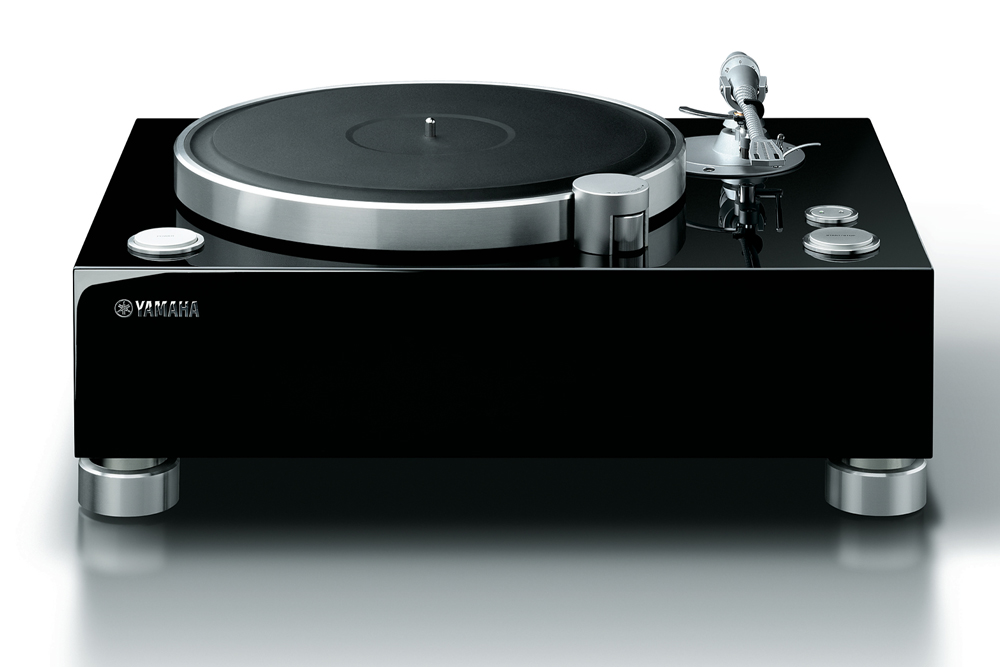
Assembly of the GT-5000 was straight forward but I will note that the specially designed vibration absorbing feet are not adjustable for leveling, so the surface that carries the turntable will have to be level or shims placed under the feet. The cotton gloves come in handy when placing the belt over the pulley and sub platter keeping hand oils from sensitive surfaces.
The main platter is positioned next using the provided handles, then the pitch control cover that also acts as a hand rest when positioning the tonearm. The main platter is larger than an LP and features a scalloped groove to allow for fingers to pick up a record without disturbing the platter – even while it’s spinning.
The onboard motor is a 24-pole 2-phase AC synchronous type. Motor construction is of the coreless type. AC Power to the motor is produced from circuitry that includes a crystal oscillator that ensures correct and steady RPM. The two turntable speeds of 33 1/3 and 45 RPM are set by the speed control sited behind the Start/Stop button. It features an embedded green LED above each of the selected speeds.
Next to the oversized platter is the pitch control knob that allows for precise speed setting in steps of 0.1%, using the supplied strobe disc and light. The light is plugged into the back of the turntable at the ‘jack’ marked ‘Strobe’. This is easy to use due to the chevron markings on the metal plate which become steady once the correct speed is dialled in. The strobe disc also carries the cartridge overhang information, however, the markings are quite wide – I would see this as only a rough guide for cartridge setup.
The short and straight tonearm is of the static balanced type and is constructed around an aluminium tube which is copper plated on the inside and outside. The tonearm tube is then wrapped with four layers of carbon fibre weave which further strengthens the arm. The use of various materials in the arm allows engineers to control unwanted vibration and stiffen the design. The tonearm tube gradually widens at the back before passing through the horizontal bearing assembly. Low friction bearings are used in both the vertical and horizontal planes.
Two different-sized counterweights are supplied and can be used with cartridges weighing 16 grams to 23.5 grams for the small and 23 grams to 34 grams for the larger counterweight. A removable aluminium headshell is supplied that has the ability to allow for azimuth adjustment to the cartridge. This weighs 14 grams. The tonearm lift is of a sturdy design and the tonearm allows for arm height adjustment through the loosening of an Allen key bolt at the tonearm base.
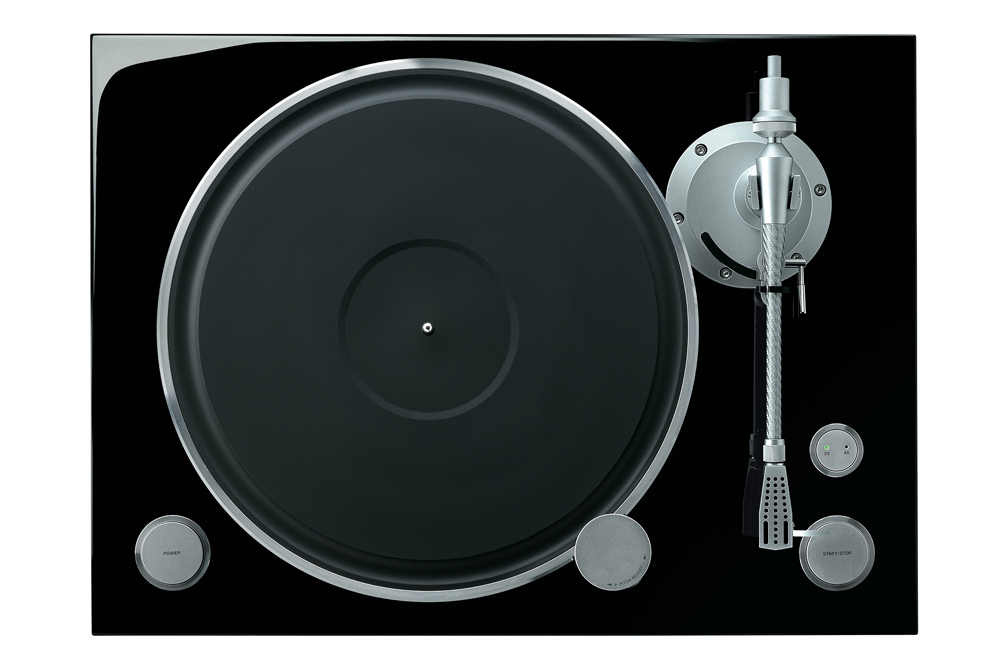
There is no anti-skate adjustment for the arm as the short zero offset design does not require it. During the cartridge setup, I can attest that the anti-skate test track showed low figures of 1.3% IMD (inter-modulated distortion) in both left and right channels that are perfectly acceptable.
The tonearm carbon fibre wrap is finished in silver giving the whole arm a uniform and understated elegance. At the back of the Yamaha GT-5000 are female connections for both RCA and XLR connectors. If the GT-5000 is used with the partnering Yamaha C-5000 preamplifier and M-5000 power amplifier a fully balanced signal transmission can be obtained with XLR leads.
The Yamaha GT-5000 that came in for review also had an unmounted Van Den Hul ‘The Frog’ Moving Coil (MC) cartridge, so I went ahead with my usual setup procedures, firstly looking at the physical alignment of the cartridge under a microscope. Zenith alignment was out by approximately 1.8 degrees and the Azimuth looked close to the ideal of 90 degrees to the cartridge body.
The Stylus Rake Angle also looked good. I’d like to note that stylus/cantilever manufacturers have acceptable tolerances of +/- 5 degrees in the three areas just mentioned so the The Frog cartridge gets a green light, pun intended! The Frog was then placed on the headshell and set to the correct overhang of 17 mm or 52 mm from stylus tip to the start of the headshell to arm coupler using a vernier calliper.
With the headshell fixed to the tonearm I then tried to use my usual alignment protractors, but because these are designed for tonearms utilising the offset angle at the headshell, the straight GT-5000 tonearm does not have an offset.
So, back under the microscope went the headshell and cartridge to align the Zenith of the stylus to 90 degrees to the longitude length of the headshell/arm. During the electronic alignment of the cartridge Zenith, distortion figures of 3% were achieved, so an acceptable result.
Why is this important? I hear some of you ask. Well, that’s because the GT-5000 arm has no offset angle, the normal tracking error on the radially swinging arm is higher than tonearms with offset angles. Yamaha engineers chose the straight tonearm style for greater dynamic music performance at the expense of some minor errors in tracking. So, if the cartridge is very well aligned at the record null points, then the better the overall sound quality. Worth doing.
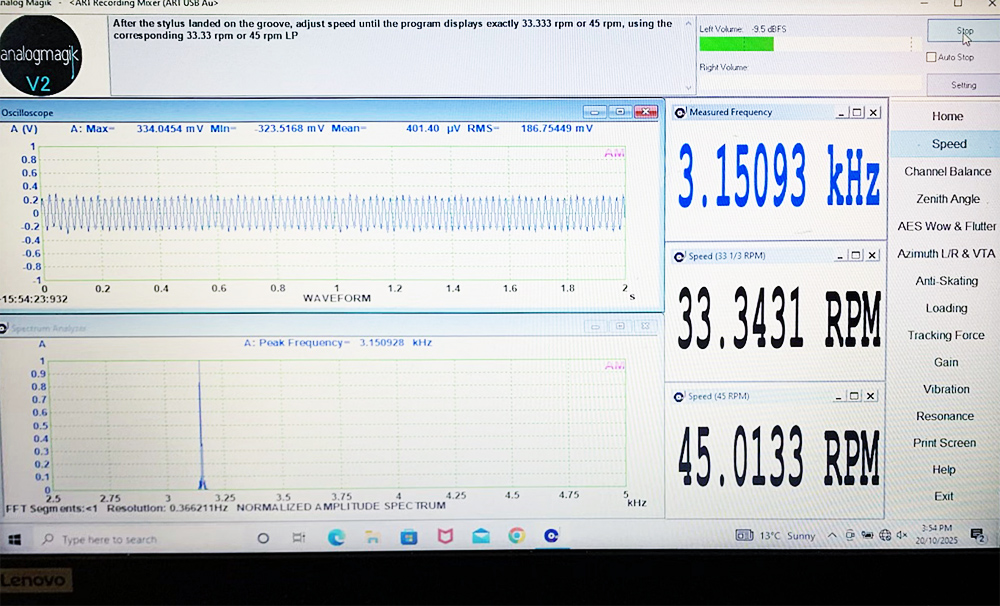
Azimuth readings of minus 28dB on both channels were achieved which will give good stereo separation. Also, the speed was adjusted to reach 33 1/3 rpm with a low figure for wow and flutter of just 0.0768%. We’re getting into good direct drive and idler drive territory here. As mentioned before, anti-skate figures of 1.3% IMD in both channels are good results.
Orbital Fortitude
Now, to the important stuff. How does the GT-5000 operate and sound? Hit the large round power button on the left hand side of the platter, then select the speed on the smaller button on the right hand side. In front of the speed control is a large button for Start/Stop. Press that, and the plinth builds up to the correct speed in approximately 10 seconds, driven by the motor’s torque control. Place the tonearm over the record and the music starts…
As a starter to the music meal Latin Rock a-Go Go is a 1968 Japanese production of Bossa Nova-style music recorded on the Stereocolor Nivico Productions. Lounge music at its best? Or well recorded Cheese? The jazz noodling’s on the LP do have a lot of audiophile sound about them.
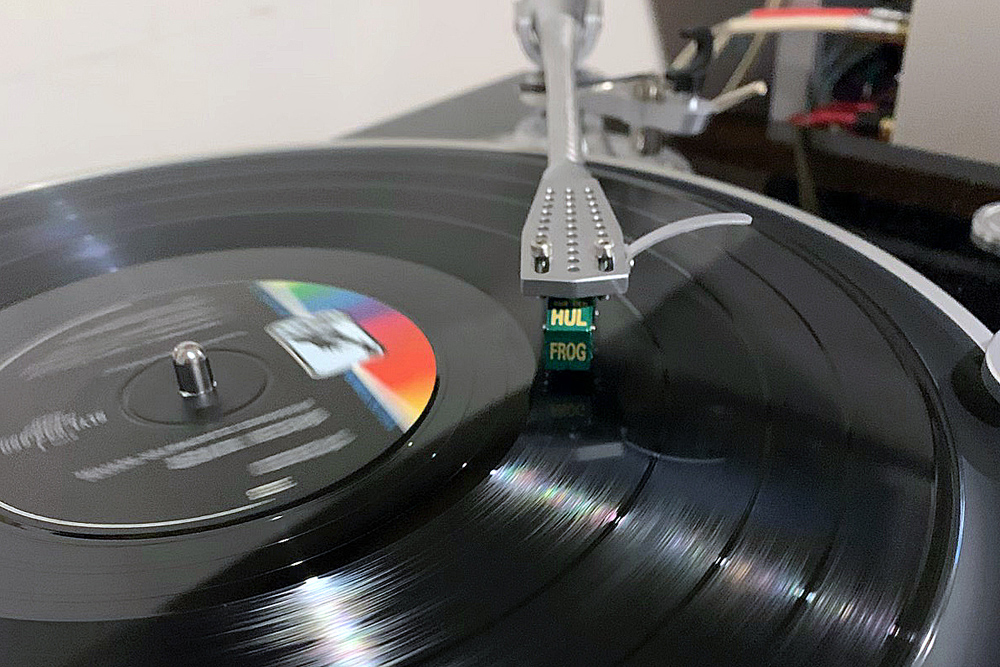
Clear details emerge from quiet backgrounds with the brass instrumentation of the trumpet having great rendition and naturalness. Drums are dynamic with no flabbiness or overhang. The timbre of the drums sound correct, with the listener able to hear the sound of the skins changing during the stick striking. The glockenspiel rings out with the leading edges of the notes cutting through the mix, showing the GT-5000’s ability to lay out the instruments with natural accuracy. The soundstage is wide and tall with good forward projection. All is balanced, fluid and with great pace. If I didn’t know the Yamaha GT-5000 was belt driven I could have sworn it was a direct drive, given the weighty presentation, particularly with the percussion.
Trumpet & Organ, Music of the Baroque is a one-step recording on the Water Lily Acoustics label from 1990. Its rendition via the GT-5000 correctly captures the recording space of the Californian church where the organ resides. The recording chain uses tubes throughout, including the microphones, microphone preamps and the Ampex reel-to-reel. The GT-5000 portrays the natural sounds that tubes can produce, with the naturalness of the trumpet flowing from the speakers. Dynamic swings from soft to loud are handled very well with no slackness to the sound, something that can be present on some lesser belt drive designs.
The organ notes are very detailed in both soft and loud passages, the trumpet has a natural brassy bite that never goes too far. The soundstage has great depth, height and width giving the music its correct sense of scale. Despite RCA cables being used with my OTL tubed phono stage, the sound came from a quiet background with no evidence of hum or background noise. This is a sign of the GT-5000’s well-sorted grounding system. Vinyl listeners who have the ability to use balanced cables over longer runs should welcome even lower noise floor levels.
Creedence Clearwater Revival’s 20 Golden Greats on the Fantasy Label (1979) has 10 tracks crammed per side and the recording dynamics suffer due to this. However, the Yamaha GT-5000 makes a good fist of the track “Run Through the Jungle” with John Fogerty’s gravelly voice captured well in this lopping blues classic. The harmonica and Hammond organ are well sorted and swell into the listening room. The drums lack a little power but, again, I put this down to the limited physical recording space on the record.
Staying with Creedence Clearwater Revival, but this time I’m playing the Green River album on the Liberty label (1969). Playing the album’s title track shows what a well recorded LP is capable of producing. There’s greater clarity on vocals, guitars have better leading edge definition, and the whole track has a wonderful sense of boogie about it. The pace and timing of the GT-5000 is spot on, with the sonic image filling the listening space.
The Dave Brubeck Quartet’s Time Out on the Coronet Label (1960) is of course one of the all-time jazz classics and I rate this pressing as one the best I have heard. The GT-5000 gets the detail, scale and dynamics of this recording just right. The piano is clear and crisp, the drumming and cymbal sounds are explicit without being harsh, the dynamics are expressive when present. The piano is particularly well rendered, with the micro details within the notes a pure joy to listen to. Paul Desmond’s alto sax on the track “Strange Meadow Lark” has a breathy and natural sound to it. The Yamaha GT-5000 has the ability to dig deep on this LP, uncovering the brilliant recording.

Last on the platter is the prog-metal juggernaut that is TOOL’s Fear Inoculum on the Tool Dissectional Label (2019). This is a sprawling album across three LPs and clearly shows the power and performance of the GT-5000. Gigantic and Tremendous are exactly the sounds developed from this album with the track “Pneuma” powering out of the speakers. The song builds slowly over guitar and percussive tricks before the song’s brilliant riffing guitar kicks in, with Maynard James Keenan’s vocals supplying controlled menace and tension. High-powered drumming and guitars swell from heavy to soft, showcasing the great control the GT-5000’s platter drive and short dynamic tone arm bring to the performance. Controlled, powerful, room-filling and head-banging! What more could anyone want? The GT-5000 does subtlety as assuredly as power in perfect combination.
Conclusion
As an all-in-one package, the Yamaha GT-5000 brings ease of use and high quality engineering in a relatively compact chassis that majors in correct speed, dynamics and fluidity of sound.
Add in nice touches such as the supplied strobe for speed checking and the balanced output connections, means that Yamaha has every right to name this turntable as it sounds… truly GIGANTIC and TREMENDOUS!
… Mark Busby
www.soundstageaustralia.com
Associated Equipment
- Speakers – Yamaha NS-1000M, custom 18-inch subwoofer
- Preamplifier – PS Audio BHK, Music First Audio step up transformer, EMIA two-box tube phono stage
- Amplifier – Yamaha B1, Musical Fidelity Tri-Vista 300, Leak Stereo 60, restored Leak Stereo 20
- Sources – Analogue: Technics SP10 Mk3 turntable with Stax UA7 Tonearm, Garrard 410 and SME V arm, Thorens TD 124 Mk1 with Woodsong bearing, SME 3012 silver wired tonearm, Music Maker 3 moving iron & DS Audio DS-003 optical cartridges, Soundsmith Paua, Miyajima Labs Kotetu, Kiseki Blue cartridges, Tube Sound Audio phono stage, Sansui TU-717 tuner. Digital: Marantz CD-12/DAC-12
- Cables – Vertere Pulse-C, Revelation Audio Labs
Yamaha GT-5000 Turntable
Price: AU$12,999
Australian Warranty: Five Years Standard, Additional Five Years with Registration
Australian Distributor: Yamaha Music Australia
+61 1800 805 413
www.yamaha.com.au
Yamaha Corporation
10-1, Nakazawa-cho, Naka-ku
Hamamatsu Shizuoka 430-8650, Japan
+81 (53) 460-2211
www.yamaha.com

